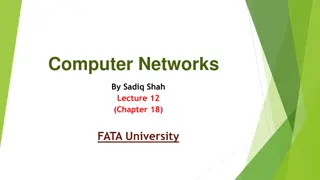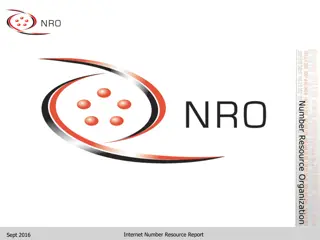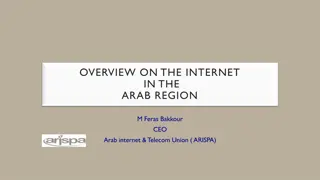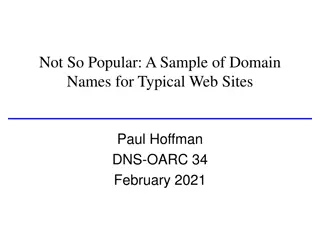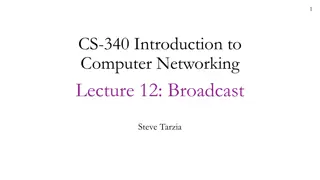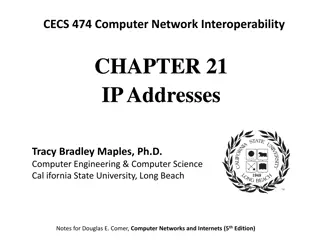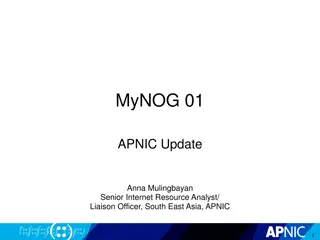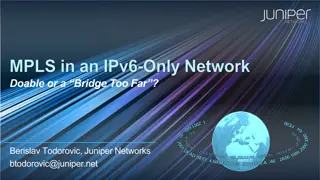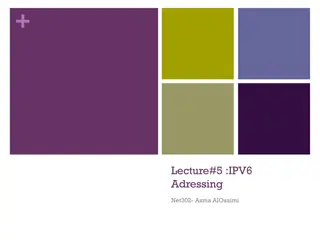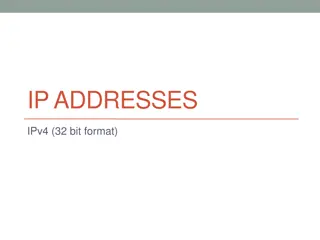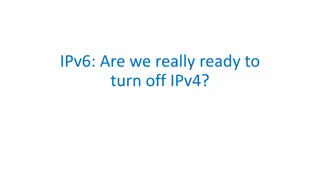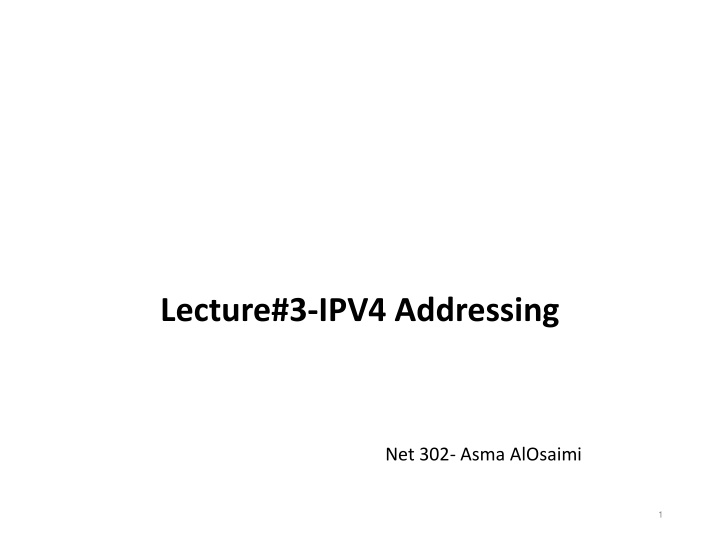
Mastering IPv4 Addressing: Structure, Subnetting, and Operations
Explore the fundamentals of IPv4 addressing including structure, subnet masks, unicast/broadcast/multicast types, binary conversions, subnetting, valid subnet masks, prefix length examination, and network/host/broadcast address determination. Learn about bitwise AND operations for IPv4 subnetting.
Download Presentation

Please find below an Image/Link to download the presentation.
The content on the website is provided AS IS for your information and personal use only. It may not be sold, licensed, or shared on other websites without obtaining consent from the author. If you encounter any issues during the download, it is possible that the publisher has removed the file from their server.
You are allowed to download the files provided on this website for personal or commercial use, subject to the condition that they are used lawfully. All files are the property of their respective owners.
The content on the website is provided AS IS for your information and personal use only. It may not be sold, licensed, or shared on other websites without obtaining consent from the author.
E N D
Presentation Transcript
Lecture#3-IPV4 Addressing Net 302- Asma AlOsaimi 1
Topics IPv4 Address Structure IPv4 Subnet Mask IPv4 Unicast, Broadcast, and Multicast Types of IPv4 Address 2
IPv4 Address Structure Binary Number System 3
IPv4 Address Structure Converting a Binary Address to Decimal 4
IPv4 Address Structure Converting from Decimal to Binary (Cont.) 5
IPv4 Subnet Mask Network Portion and Host Portion of an IPv4 Address To define the network and host portions of an address, a devices use a separate 32-bit pattern called a subnet mask The subnet mask does not actually contain the network or host portion of an IPv4 address, it just says where to look for these portions in a given IPv4 address 6
IPv4 Subnet Mask Network Portion and Host Portion of an IPv4 Address (cont.) Valid Subnet Masks 7
IPv4 Subnet Mask Examining the Prefix Length 8
IPv4 Subnet Mask Examining the Prefix Length (cont.) 9
IPv4 Subnet Mask IPv4 Network, Host, and Broadcast Address 10.1.1.0/24 10
IPv4 Subnet Mask First Host and Last Host Addresses 10.1.1.0/24 11
IPv4 Subnet Mask Bitwise AND Operation 1 AND 1 = 1 1 AND 0 = 0 0 AND 1 = 0 0 AND 0 = 0 12
IPv4 Subnet Mask Exercise what is the subnet Id of the IP address 165.212.18.5/20? The subnet Id of the IP address 165.212.18.5/20 is 165.212.16.0 The available host address range is 165.212.16.1 - 165.212.31.254 Broadcast address: 165.212.31.255 13
IPv4 Subnet Mask Exercise You have an IP address of 156.16.3.47 with an 11-bit subnet mask. What are your valid hosts? 156.16.3.47 is a class B IP address and is normally used with a subnet mask of type 255.255.x.x 11 bit subnet mask is equivalent to 255.224.0.0=11111111.11100000.00000000.00000000 Netmask - 255.224.0.0 Network address -156.0.0.0/11 Broadcast: 156.31.255.255 Host Min: 156.0.0.1 Host max: 156.31.255.254 Host/Network-2097150 14
IPv4 Subnet Mask Exercise What does the IP address 172.17.4.250/24 represent? a) network address b) multicast address c) host address d) broadcast address 15
IPv4 Unicast, Broadcast, and Multicast Assigning a Static IPv4 Address to a Host LAN Interface Properties Configuring a Static IPv4 Address 16
IPv4 Unicast, Broadcast, and Multicast Assigning a Dynamic IPv4 Address to a Host Verification DHCP The preferred method of assigning IPv4 addresses to hosts on large networks because it reduces the burden on network support staff and virtually eliminates entry errors. 17
IPv4 Unicast, Broadcast, and Multicast Unicast Transmission In an IPv4 network, the hosts can communicate one of three different ways: Unicast, Broadcast, and Multicast #1 Unicast the process of sending a packet from one host to an individual host. 18
IPv4 Unicast, Broadcast, and Multicast Broadcast Transmission In an IPv4 network, the hosts can communicate one of three different ways: Unicast, Broadcast, and Multicast. #2 Broadcast the process of sending a packet from one host to all hosts in the network. Directed broadcast Destination 172.16.4.255 Hosts within the 172.16.4.0/24 network NOTE: Routers do not forward a limited broadcast! Directed broadcast Destination 172.16.4.255 Hosts within the 172.16.4.0/24 network 19
IPv4 Unicast, Broadcast, and Multicast Multicast Transmission In an IPv4 network, the hosts can communicate one of three different ways: Unicast, Broadcast, and Multicast. #3 Multicast The process of sending a packet from one host to a selected group of hosts, possibly in different networks. Reduces traffic Reserved for addressing multicast groups 224.0.0.0 to 239.255.255.255. Link local 224.0.0.0 to 224.0.0.255 (Example: routing information exchanged by routing protocols) Globally scoped addresses 224.0.1.0 to 238.255.255.255 (Example: 224.0.1.1 has been reserved for Network Time Protocol) 20
Types of IPv4 Address Public and Private IPv4 Addresses Private address blocks are: Hosts that do not require access to the Internet can use private addresses 10.0.0.0 to 10.255.255.255 (10.0.0.0/8) 172.16.0.0 to 172.31.255.255 (172.16.0.0/12) 192.168.0.0 to 192.168.255.255 (192.168.0.0/16) Shared address space addresses: Not globally routable Intended only for use in service provider networks Address block is 100.64.0.0/10 21
Types of IPv4 Address Special Use IPv4 Addresses Network and Broadcast addresses within each network the first and last addresses cannot be assigned to hosts Loopback address 127.0.0.1 a special address that hosts use to direct traffic to themselves (addresses 127.0.0.0 to 127.255.255.255 are reserved) Link-Local address 169.254.0.0 to 169.254.255.255 (169.254.0.0/16) addresses can be automatically assigned to the local host TEST-NET addresses 192.0.2.0 to 192.0.2.255 (192.0.2.0/24) set aside for teaching and learning purposes, used in documentation and network examples Experimental addresses 240.0.0.0 to 255.255.255.254 are listed as reserved 22
in text case for consistency. Types of IPv4 Address Legacy Classful Addressing 23
Types of IPv4 Address Legacy Classful Addressing (cont.) Classless Addressing Formal name is Classless Inter-Domain Routing (CIDR, pronounced cider Created a new set of standards that allowed service providers to allocate IPv4 addresses on any address bit boundary (prefix length) instead of only by a class A, B, or C address 24
Recourses Cisco Networking Academy program , Introduction to Networks 25



